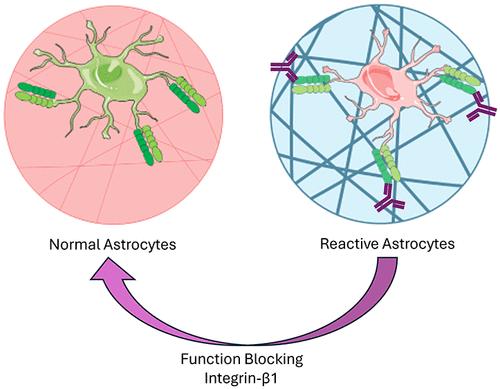Development of Tissue-Engineered Model of Fibrotic Scarring after Spinal Cord Injury to Study Astrocyte Activation and Neurite Outgrowth In Vitro
IF 5.4
2区 医学
Q2 MATERIALS SCIENCE, BIOMATERIALS
引用次数: 0
Abstract
Traumatic spinal cord injuries (SCI) are debilitating injuries affecting twenty-seven million people worldwide and cause functional impairments. Despite decades of research and medical advancements, current treatment options for SCI remain limited, in part due to the complex pathophysiology of spinal cord lesions including cellular transformation and extracellular matrix (ECM) remodeling. Recent studies have increased focus on fibrotic scarring after SCI, and yet much remains unclear about the impact of fibrotic scarring on SCI lesion progression. Here, using collagen and decellularized spinal cord-based composite hydrogels, a three-dimensional (3D) cell culture model mimicking the fibrous core of spinal cord lesions was implemented to investigate its influence on the surrounding astrocytes. To mimic the fibrotic milieu, collagen fibril thickness was tuned using previously established temperature-controlled casting methods. In our platforms, astrocytes in fibro-mimetic hydrogels exhibited increased levels of activation markers such as glial fibrillary acidic protein and N-cadherin. Furthermore, astrocytes in fibro-mimetic hydrogels deposited more fibronectin and laminin, further hinting that astrocytes may also contribute to fibrotic scarring. These markers were decreased when Rho-ROCK and integrin β1 were inhibited via pharmacological inhibitors. Mechanistic analysis of Yes-associated protein reveals that blocking integrin β1 prevents mechanosensing of astrocytes, contributing to altered phenotypes in variable culture conditions. In the presence of these inhibitors, astrocytes increased the secretion of brain-derived neurotrophic factor, and a greater degree of dorsal root ganglia neurite infiltration into the underlying hydrogels was observed. Altogether, this study presents a novel tissue-engineered platform to study fibrotic scarring after SCI and may be a useful platform to advance our understanding of SCI lesion aggravation.

开发脊髓损伤后纤维化瘢痕组织工程模型,研究星形胶质细胞活化和神经元体外生长
创伤性脊髓损伤(SCI)是一种使人衰弱的损伤,影响着全球 2,700 万人,并导致功能障碍。尽管经过数十年的研究和医学进步,目前针对 SCI 的治疗方案仍然有限,部分原因是脊髓损伤的病理生理学非常复杂,包括细胞转化和细胞外基质(ECM)重塑。最近的研究更加关注 SCI 后的纤维化瘢痕,但纤维化瘢痕对 SCI 病变进展的影响仍有很多不清楚之处。在此,我们使用胶原蛋白和脱细胞脊髓基复合水凝胶,建立了一个模仿脊髓病变纤维核心的三维(3D)细胞培养模型,以研究其对周围星形胶质细胞的影响。为了模拟纤维化环境,使用先前建立的温控浇铸方法调整了胶原纤维的厚度。在我们的平台中,仿纤维水凝胶中的星形胶质细胞表现出更高水平的活化标记物,如胶质纤维酸性蛋白和 N-粘连蛋白。此外,仿纤维水凝胶中的星形胶质细胞沉积了更多的纤维粘连蛋白和层粘连蛋白,这进一步表明星形胶质细胞也可能导致纤维化瘢痕。通过药物抑制剂抑制 Rho-ROCK 和整合素 β1 时,这些标记物会减少。对Yes相关蛋白的机制分析表明,阻断整合素β1可阻止星形胶质细胞的机械传感,从而导致在不同培养条件下的表型改变。在这些抑制剂存在的情况下,星形胶质细胞增加了脑源性神经营养因子的分泌,并观察到背根神经节神经元更大程度地浸润到下层水凝胶中。总之,这项研究为研究 SCI 后的纤维化瘢痕提供了一个新颖的组织工程平台,并可能成为促进我们了解 SCI 病变加重的有用平台。
本文章由计算机程序翻译,如有差异,请以英文原文为准。
求助全文
约1分钟内获得全文
求助全文
来源期刊

ACS Biomaterials Science & Engineering
Materials Science-Biomaterials
CiteScore
10.30
自引率
3.40%
发文量
413
期刊介绍:
ACS Biomaterials Science & Engineering is the leading journal in the field of biomaterials, serving as an international forum for publishing cutting-edge research and innovative ideas on a broad range of topics:
Applications and Health – implantable tissues and devices, prosthesis, health risks, toxicology
Bio-interactions and Bio-compatibility – material-biology interactions, chemical/morphological/structural communication, mechanobiology, signaling and biological responses, immuno-engineering, calcification, coatings, corrosion and degradation of biomaterials and devices, biophysical regulation of cell functions
Characterization, Synthesis, and Modification – new biomaterials, bioinspired and biomimetic approaches to biomaterials, exploiting structural hierarchy and architectural control, combinatorial strategies for biomaterials discovery, genetic biomaterials design, synthetic biology, new composite systems, bionics, polymer synthesis
Controlled Release and Delivery Systems – biomaterial-based drug and gene delivery, bio-responsive delivery of regulatory molecules, pharmaceutical engineering
Healthcare Advances – clinical translation, regulatory issues, patient safety, emerging trends
Imaging and Diagnostics – imaging agents and probes, theranostics, biosensors, monitoring
Manufacturing and Technology – 3D printing, inks, organ-on-a-chip, bioreactor/perfusion systems, microdevices, BioMEMS, optics and electronics interfaces with biomaterials, systems integration
Modeling and Informatics Tools – scaling methods to guide biomaterial design, predictive algorithms for structure-function, biomechanics, integrating bioinformatics with biomaterials discovery, metabolomics in the context of biomaterials
Tissue Engineering and Regenerative Medicine – basic and applied studies, cell therapies, scaffolds, vascularization, bioartificial organs, transplantation and functionality, cellular agriculture
 求助内容:
求助内容: 应助结果提醒方式:
应助结果提醒方式:


